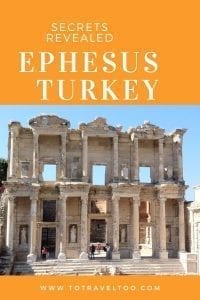Secrets Revealed of Ephesus, what are they and will they ever be revealed? Our guide will assist you in planning your visit.
If you are visiting Turkey you should make plans to visit Ephesus. It is Turkey’s grandest ancient site and the best way to see it is to spend the night at Selcuk and plan to spend most of the day visiting Ephesus.
Ephesus has been said to be second in importance to the site of Pompeii in Italy.
Ephesus is located 3 km southwest of Selcuk in Turkey. The area dates back to the Neolithic Ages – 6,000 B.C. During the 3rd millennium BC the city was known as Apasas, the name taken from a successful Amazon Queen. In fact, some say that the city was founded by female warrior Amazons from Anatolia. Legends abound about the fierce women warriors who did not like men and used men only for fertility. The women used to amputate their right breast so they could be faster and better equipped at archery.
Ephesus has the largest collection of Roman Ruins in the Eastern Mediterranean region. It is known as “Efes” in Turkish. Excavations began in 1863. It was once the greatest seaport in the region.
This post may contain affiliate links. Please see our disclosure for more information.
Entrance Ticket for Ephesus
Entry Ticket and Self Guide Audio
Do You Need a Visa for Turkey?
You will need to complete a Health Declaration Form for entering Turkey.
Where to Stay in Ephesus – The Closest Town is Selcuk
Celsus Boutique Hotel: Ataturk Mahallesi Sokak #2
Offers a pool, free breakfast, sauna and kids stay free.
Hotel Nazar: Isabey Mah. Sehit Polis Metin Ta Vaslioglu Cad #34
Offers a rooftop terrace, pool, free breakfast included.
Where is Ephesus
Ephesus is located 3 km southwest of the town of Selcuk. Istanbul is located 680km away. The original settlement was closer to the Aegean Sea than the current location which sits around 8km away.
The Bouleuterion (Odeon)
The Bouleuterion was constructed in the 2nd century A.D. in the shape of a small theatre. It was used for the meetings of the Senate (Boulea) and as a concert hall holding 1500 spectators.

Hadrian’s Gate
Hadrian’s Gate is located at the junction of Curetes and Marble Street. It was dedicated to Hadrian in honour of his visits to the city. When we were visiting Antalya in Turkey we ventured through another Hadrian’s Gate in the Old Quarter.

The Temple of Hadrian
The Temple of Hadrian at Ephesus was built before 138 AD and dedicated to Emperor Hadrian. It is one of the most beautiful and preserved structures on Curetes Street.
Emperor Hadrian was known as one of the 5 Good Emperors but he was a man of many secrets. Some say that he tried to poison his wife and stories abound about the mysterious death of his young friend Antinous. Antinous fell overboard on a boat trip that the two of them took down the Nile.

Hercules Gate
As you can see, Hercules Gates was constructed narrower than the road, this was to prevent the wheeled chariots from going into the city. When you pass through the gates you will notice the smoothness of the road as a result of less wheeled traffic passing through. A relief of Hercules can be found on each gate.

Curetes Street
A 210m long main boulevard with porticoes and marble paving that lies between Hercules Gate and Celsus Library.
How did Curetes Street get its name? Priests of Artemis were known as Curetes and they assisted him in the birthing of infants. Some say that the french word curettage which means abortion comes from the Curetes of Ephesus.

Celsus Library
Celsus Library was built in 110BC and housed over 12,000 scrolls which were kept in the niches of the walls. The scrolls were made out of parchment which comes from the skin of sheep or goats and papyrus.
Secret: an underground tunnel was constructed between the library to a brothel or a drinking establishment.

Four statues are located in the niches at the front of the Library representing Wisdom, Valor, Thought and Knowledge.

Fountain House
Fountain House was constructed during the 3rd century B.C. It is located behind the Great Theatre’s stage. An inscription on one of the columns states that the water collected here was brought in from the Marnas River 15km away.

The Grand Theatre
The magnificent Grand Theatre was first constructed during the 3rd century B.C. and later enlarged to its current size during the Roman Period. It has a capacity of 25,000 seats divided into 3 sections:
- lower marbled section – Emperor’s Box
- seats with backs – reserved for VIP’s of the day
- seats located higher up – for the general public
The Theatre was used for:
- concerts and plays
- religious, political and philosophical discussions
- gladiator and animal fights
The Theatre Gymnasium
The Theatre Gymnasium located in front of the Theatre had lobbies, warm bathing pools, a frigidarium (cold baths), recreation rooms and halls for training.
The Temple of Artemis

Temple of Artemis Facts:
- It is one of the 7 Wonders of the Ancient World due to its size, it was known to be double the size of the Parthenon.
- The original was destroyed by fire
- In 401 CE it was torn down by a mob of Christians
- All that remains is one column
- Artemis was the God of Chastity, childbirth, fertility, hunting, wild animals and forests
Pro Tip:
Enter Ephesus from the Upper Gate – this is an easier walk downhill to the lower gate (exit).
Take plenty of water and sunscreen with you.
Entrance Fees
- Ephesus: TL 220, Euro 11.5, USD 11.20
- House of Mary: TL 120 Euro 6.5 USD 6.80
- Temple of Artemis: Free of Charge
- St. John’s Basilica: TL 50, Euro 3, USD 2.80
- Sirince Village: Free of charge
- Isa Bey Mosque: Free of Charge
- Terrace Houses: TL 85, Euro 5, USD 4.80
- Ephesus Museum: TL 50, Euro 3, USD 2.80
Tours Available to Ephesus
Available tours from different locations to visit Ephesus:
Getting In To Ephesus
How to get to Ephesus
1. You can take a taxi from Selcuk – organise the taxi to drop you at the top and pick you up from the bottom
2. You can walk from Selcuk it will take between 30 – 45 minutes. We would not recommend this in the height of summer unless you leave very early in the morning and arrive when the gates open at 8 am.
3. You can fly from Istanbul to Izmir – a taxi from Izmir airport to Ephesus will take 45 minutes.
4. During Summer from 1st April through to 31st October, there are ferries from the Greek Island of Samos.
Flight Deals to Izmir and Istanbul
Find the cheapest flights with Skyscanner our ‘go-to’ when researching and booking flights throughout the world.
When is the best time to visit Ephesus
During the months of April, May, October and November are the best times to visit Ephesus.
The coldest months are January and February with average daily temperatures of 10 degrees C.
The hottest months are July and August with temperatures reaching 43 degrees C.
The wettest months are April and October.
Avoid the heat during the middle of the day and visit first thing in the morning or late in the afternoon.
It can be very busy with busloads of cruise passengers visiting in the busy summer periods.
Travel Insurance
We recommend taking out travel insurance as soon as you book your flights and pay deposits on any cruises, tours or hotels.
Do You Need a Turkish Visa
Are you on Pinterest? We are at To Travel Too and we have many travel-related boards check us out at Pinterest. If you enjoyed our article why not pin it to your board.
To Travel Too Travel Shop
Travel smarter and safer with products from our To Travel Too Travel Shop. If you are looking for the latest luggage, guidebooks or travel accessories we have you covered with over 800 travel products to choose from.
In conclusion, Ephesus is a truly remarkable destination that offers visitors an immersive experience of the rich history and culture of ancient Turkey. From the awe-inspiring ruins of the Library of Celsus to the fascinating Terrace Houses, secrets and mysteries abound at every corner. The city’s well-preserved structures and impressive monuments provide a glimpse into the past, allowing us to connect with civilizations that once thrived in this thriving metropolis. Whether you are an archaeology enthusiast or simply seeking to explore hidden gems off the beaten path, Ephesus promises an unforgettable journey filled with surprises and wonders. So pack your bags and embark on a voyage through time as you unravel the captivating secrets of Ephesus Turkey.









January 2020 Entrance Fees Update.
Entrance Fees: Ephesus Turkish Lira 72.00
Entrance Fees: House of Mary Turkish Lira 35
Temple of Artemis – free entrance
Thanks Mehmet
Cheers Jane and Duncan